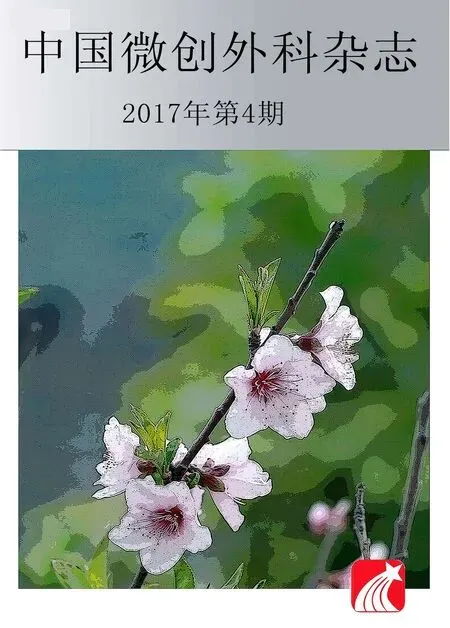泮托拉唑和吉法酯治疗双联抗血小板所致上消化道出血的对比研究
2017-01-15尤嘉璐
刘 莹 尤嘉璐 石 进
(首都医科大学附属北京安贞医院消化内科,北京 100029)
·临床论著·
泮托拉唑和吉法酯治疗双联抗血小板所致上消化道出血的对比研究
刘 莹 尤嘉璐 石 进*
(首都医科大学附属北京安贞医院消化内科,北京 100029)
目的 探讨质子泵抑制剂(proton pump inhibitor,PPI)泮托拉唑和胃黏膜保护剂吉法酯对经皮冠状动脉介入(percutaneous coronary intervention,PCI)术后服用双联抗血小板药物患者上消化道出血的预防效果。 方法 1263例PCI术后服用肠溶阿司匹林合并氯吡格雷纳入本研究,按治疗小组分为4组:常规治疗组(n=332)、PPI组(n=318)、胃黏膜保护剂组(n=299)、PPI+胃黏膜保护剂组(n=314)。随访6个月,观察患者的消化道症状、上消化道出血、主要心脏不良事件(major adverse cardiac events,MACE)、不良反应等。 结果 52例6个月内发生上消化道出血,其中常规治疗组21例,PPI组9例,胃黏膜保护剂组15例,PPI+胃黏膜保护剂组7例,4组6个月内上消化道出血发生率有统计学差异(χ2=8.883,P=0.031),其中常规治疗组显著高于PPI组和PPI+胃黏膜保护剂组(P<0.05),其他各组间消化道出血发生率无统计学差异(P>0.05)。术后3个月内发生上消化道出血34例,占全部上消化道出血65.4%(34/52),4组消化道出血的发生时间无统计学差异(χ2=4.212,P=0.648)。 结论 泮托拉唑或泮托拉唑联合吉法酯口服可降低PCI术后双联抗血小板药物患者上消化道出血的发生率。上消化道出血的预防性治疗应从PCI术后第1天开始,至少维持3~6个月,甚至更长。
质子泵抑制剂; 胃黏膜保护剂; 阿司匹林; 氯吡格雷; 抗血小板; 上消化道出血
双联抗血小板治疗(氯吡格雷联合阿司匹林口服治疗)目前已被常规应用于经皮冠状动脉介入术(percutaneous coronary intervention,PCI)后以预防血栓形成,防止支架内再狭窄的发生,从而降低主要不良心血管事件[1]。但双联抗血小板治疗同时增加了上消化道出血的发生率。上消化道损伤多以胃十二指肠炎或胃十指肠溃疡为主[2]。消化道出血可导致患者死亡率增加及接受抗血小板治疗的依从性下降,进而导致临床预后恶化。PCI术后预防消化道出血与预防支架内血栓形成同样重要[3]。2010年亚太非静脉曲张上消化道出血共识中,专家组建议服用双重抗血小板治疗的患者有必要加用质子泵抑制剂(proton pump inhibitor,PPI)预防上消化道出血[4]。Gerson等[5]meta分析认为,PPI和氯吡格雷之间并无明确的相互作用,但在不同研究中得到的结果差异是由于潜在的混杂因素所致。目前,胃黏膜保护剂对PCI术后患者上消化道出血的影响数据尚缺乏。本研究观察我院2012年1~7月1263例冠状动脉粥样硬化性心脏病(冠心病)PCI术后服用抗血小板药物同时服用PPI药物或胃黏膜保护剂能否减少上消化道出血的发生率,旨在探讨PCI术后上消化道出血的防治措施。
1 临床资料与方法
1.1 一般资料
我院2012年1~7月行PCI 1263例,男956例,女307例。年龄29~89岁,(60.0±9.9)岁。按治疗小组分为4组:常规治疗332例(常规治疗组),PCI术后应用肠溶阿司匹林100 mg,1次/d口服和氯吡格雷75 mg,1次/d口服;泮托拉唑治疗318例(PPI组),在常规治疗基础上,术后第1天加用泮托拉唑钠(泮立苏,杭州中美华东制药,批号:111107)40 mg,1次/d口服;吉法酯治疗299例(胃黏膜保护剂组),常规治疗基础上,术后第1天加用吉法酯(惠加强-G,日本大阪生晃荣养药品,批号:GF-Z084)100 mg,3次/d口服;泮托拉唑+吉法酯治疗314例(PPI+胃黏膜保护剂组),在常规治疗基础上,术后第1天联合应用上述剂量的泮托拉唑和吉法酯。以上患者维持用药,随访时间为半年。4组患者一般资料比较除消化性溃疡史外,无统计学差异(P>0.05),见表1。
病例选择标准:①因冠心病经选择性冠状动脉造影,判断冠状动脉至少有一处狭窄,且至少在75%以上(直径法),择期接受PCI的患者;②术后常规应用肠溶阿司匹林100 mg,1次/d口服和氯吡格雷75 mg,1次/d口服;③近1年内无消化道出血史;④患者和家属知情同意。排除标准:①妊娠或哺乳期妇女;②严重的肝、肾功能不全患者;③严重感染患者;④血液系统疾病,白细胞减少者;⑤脑出血或有其他出血倾向者;⑥恶性肿瘤患者;⑦服用糖皮质激素者;⑧急诊PCI术后患者。
1.2 方法
所有患者均在术前接受冠心病常规治疗(阿司匹林、硝酸酯类药物、β受体阻滞剂、ACEI或ARB),术前均口服氯吡格雷300 mg。3 d后行PCI,术中常规穿刺桡动脉或股动脉行选择性冠状动脉造影(coronary angiography,CAG) ,经数字血管造影系统显像,行多体位左右冠状动脉造影,将存在 1 支或 1 支以上冠状动脉的直径狭窄程度≥50%者判定为冠心病患者。造影结果由有经验的专业介入心内科医师分析完成。依据 CAG 结果,确定冠脉病变范围(支数);根据病变狭窄程度分别计为无病变、<50%、轻度(50%~74%)、中度(75%~89%)、重度(≥90%)闭塞病变。按规程对主支血管的病变心脏经皮冠状动脉球囊成形(percutaneous transluminal coronary angioplasty,PTCA)后植入支架。术后氯吡格雷75 mg和阿司匹林100 mg每日1次。
1.3 观察指标
上消化道出血(发生黑便或呕血,实验室检查大便潜血阳性即判定为上消化道出血),在出血48 h内行急诊胃镜检查。
1.4 随访
2012年7月~2013年1月随访半年,每月电话随访,每3个月来医院随访,询问消化道及心血管症状,记录患者药物应用情况,吸烟、原发性高血压、糖尿病、高脂血症等控制情况,检测生化、血脂、心功能等,观察用药不良反应、主要心脏不良事件(major adverse cardiac events,MACE) 包括心血管死亡、心肌梗死、血运重建等。终点事件为术后MACE,包括心源性死亡、靶血管重建(target vessel revascularization,TVR),其中包括再次PCI 和冠状动脉脉旁路移植(coronary artery bypass grafting,CABG)和上消化道出血。
1.5 统计学处理
2 结果
2.1 4组6个月内上消化道出血发生率比较
4组6个月内上消化道出血发生率有统计学差异,其中常规治疗组显著高于PPI组和PPI+胃黏膜保护剂组(P<0.05),其他各组间消化道出血发生率无统计学差异(P>0.05),见表2。
2.2 4组发生上消化道出血时间的比较
共发生上消化道出血52例,其中术后1个月内发生上消化道出血13例,术后1~3个月21例,术后3~6个月18例,见表3,其中既往胃镜诊断消化道溃疡病史18例(常规治疗组6例,PPI组4例,胃黏膜保护剂组5例,PPI+胃黏膜保护剂组3例),既往上消化道出血9例(常规治疗组2例,PPI组2例,胃黏膜保护剂组3例,PPI+胃黏膜保护剂组2例)。4组患者上消化道出血时间构成无统计学差异,但术后3个月内发生上消化道出血34例,占全部上消化道出血患者65.4%(34/52)。
3 讨论
阿司匹林和氯吡格雷联合抗血小板治疗已经广泛应用在PCI术后或急性冠状动脉综合征(acute coronary syndrome,ACS)中,以降低支架内血栓形成及MACE的发生。多项随机对照研究证实,双联抗血小板治疗较单用阿司匹林治疗更显著改善ACS患者的临床转归[8]。近期《新英格兰杂志》总结美国心脏协会(American Heart Association,AHA)2014年公布的几项研究,包括双联抗血小板治疗(dual antiplatelet therapy,DAPT)[9]、ISAR-SAFE10]和TL-PAS[11],涉及双联抗血小板治疗时间6~30个月,但仍未得出统一结论。根据《抗血小板药物消化道损伤的预防和治疗中国专家共识(2012更新版)》,所有ACS和PCI患者术后应给予12个月双联抗血小板药物治疗[12]。但双联抗血小板治疗在减少PCI术后缺血事件发生的同时,也增加患者出血的风险[13]。全球急性冠状动脉综合征注册(global registry of acute coronary events,GRACE)研究显示,ACS患者合并大出血中,上消化道出血占31.5%,ACS 合并胃肠道出血患者死亡率高达36.3%,如果合并糖尿病,出血和出血后死亡的几率将更高。任何部位的严重出血均延长患者住院时间,增加院内死亡率[6]。
2010年美国心脏病学会基金会/美国胃肠病学会/美国心脏协会(ACCF/ACG/AHA)联合发布降低抗血小板治疗及应用NSAID 的胃肠道出血风险的专家共识,建议对接受抗血小板治疗的患者,PPI应当作为防止消化道溃疡和出血的主要药物,推荐将阿司匹林联合PPI作为阿司匹林致消化道溃疡复发风险的预防措施[14]。PPI通过抑制胃壁细胞质子泵,对胃酸产生抑制作用,且扩张胃黏膜血管改善血流增加内源性前列腺素合成,可有效改善胃肠道症状,预防上消化道出血,提高胃黏膜对阿司匹林的耐受性,同时维持胃内环境平衡,促进溃疡愈合。目前,尚无确定证据证明PPI与双联抗血小板药物合用可影响双联抗血小板药物疗效[15]。黏膜保护剂吉法酯通过增加胃黏膜的PG水平和氨基己糖浓度,增加胃黏膜的防御作用,还可能直接作用于胃黏膜上皮细胞,加速上皮细胞更新,加强黏膜保护作用[16]。
本研究PPI组和PPI+胃黏膜保护剂组的上消化道出血发生率明显低于常规治疗组,P值分别为0.034、0.011,其余各组间上消化道出血的发生率均无统计学差异(P>0.05)。可见,应用PPI或PPI联合胃黏膜保护剂可降低上消化道出血风险,单纯应用胃黏膜保护剂并未优于常规治疗组。因此,对于PCI术后CRUSADE评分提示极高危出血风险的患者,可以考虑联合使用抗血小板药物与PPI或PPI合用胃黏膜保护剂,即泮托拉唑或泮托拉唑联合吉法酯口服治疗,可降低上消化道出血的发生率,使这部分患者得到更好的临床获益。本研究4组患者既往消化性溃疡病史存在统计学差异(χ2=15.892,P=0.001),因冠心病患者出现消化道症状时,一部分患者放弃风险较大的胃镜检查,存在较多漏诊的可能,故该病史的收集存在偶然性。PPI组和PPI+胃黏膜保护剂组术前消化性溃疡史比例高,但术后上消化道出血发生率低,考虑2组预防上消化道出血的措施有效。既往有上消化道出血病史是PCI术后双联抗血小板治疗并发上消化道出血的危险因素,抗血小板药物可诱发再次出血[12],因此,术后可给予PPI预防出血的发生。
综上所述,冠心病PCI术后双联抗血小板治疗患者,术后泮托拉唑或泮托拉唑联合吉法酯口服治疗,可降低上消化道出血的发生率。PCI术后双抗患者的上消化道出血发生时间多为术后3个月内,故干预治疗从术后第1天开始,至少维持3~6个月,甚至更长。
1 Pedersen F,Butrymovich V,Kelbk H,et al. Short- and long-term cause of death in patients treated with primary PCI for STEMI.J Am Coll Cardiol,2014,64(20):2101-2108.
2 郎海波,王 平,陈 雪,等.内镜下钛夹联合医用胶与单用钛夹治疗双联抗血小板所致消化性溃疡出血的比较.中国微创外科杂志,2015,15(5):402-409.
3 Brogts JJ,Mercado N,Hu S,et al.Relation of periproeedural bleeding omplications and long-term outcome in patients undergoing percutaneous coronary revascularization(from the Evaluation of Oral Xemilofiban in Controlling Thrombotic Events[EXCITE]Trial).Am J Cardiol,2009,103(7):917-922.
4 Sung JJ,Chan FK,Chen M,et al. Asia-Pacific Working Group consensus on non-variceal upper gastrointestinal bleeding. Gut,2011,60(9):1170-1177.
5 Gerson LB. Proton pump inhibitors and potential interactions with clopidogrel: an update. Curr Gastroenterol Rep,2013,15(6): 329-336.
6 Subherwal S, Bach RG, Chen AY, et al. Baseline risk of major bleeding in non-ST-segment-elevation myocardial infarction: the CRUSADE (Can rapid risk stratification of unstable angina patients suppress adverse outcomes with early implementation of the ACC/AHA guidelines) Bleeding Score. Circulation,2009,119(14):1873-1882.
7 Killip T 3rd,Kimball JT.Treatment of myocardial infraction in a coronary care unit. A two year experience with 250 patients. Am J Cardiol,1967,20(4):457-464.
8 Kushner FG,Hand M,Smith SC Jr,et al. 2009 focused updates: ACC/AHA guidelines for the management of patients with ST-elevation myocardial infarction (updating the 2004 guidelines and 2007 focused updates) and ACC/AHA guidelines on percutaneous coronary Intervention (updating the 2005 guidelines and 2007 focused updates): a report of the American College of Cardiology Foundation/American Heart Association Task Force on Practice Guidelines. J Am Coll Cardiol,2009,54(23):2205-2241.
9 Mauri L,Kereiakes DJ,Yeh RW,et al.Twelve or 30 months of dual antiplatelet therapy after drug-eluting stents.N Engl J Med,2014,37l(23):2155-2166.
10 Byme RA,Schulz S,Mehiui J,et al.Rationale and design of a randomized double-blind,placebo-controlled of 6 versus 12 months clopidogrel therapy after implantation of a drug-eluting stent: the intracoronary stenting and antithrimbotic regimen:safety and efficacy of 6 months dual antiplatelet therapy after drug-eluting stenting (ISAR-SAFE) study.Am Heart J,2009,157(4): 620-624.e2.
11 Garratt KN,Weaver WD,Jenkins RG,et al.Prasugrel plus aspirin beyond 12 months is associated withimproved outcomes after Taxus Libere pacliaxe1-eluting coronary stent placement.Circulation,2015,131(1):62-73.
12 抗血小板药物消化道损伤的预防和治疗中国专家共识组.抗小板药物化道损伤的预防和治疗中国专家共识(2012更新版).中华内科杂志,2013,52(3):264-270.
13 黄伟杰,肖文星.PCI术后上消化道出血的研究进展.实用心脑肺血管病杂志,2012,20(7):1253-1254.
14 Abraham NS,Hlatky MA,Antman EM,et al. ACCF /ACG/AHA 2010 expert consensus document on the concomitant use of proton pump inhibitors and thienopyridines: a focused update of the ACCF/ACG/AHA 2008 expert consensus document on reducing the gastrointestinal risks of antiplatelet therapy and NSAID use. J Am Coll Cardiol,2010,56(24):2051-2066.
15 Moukarbel GV, Bhatt DL. Antiplatelet therapy and proton pump inhibition: clinician update. Circulation,2012,125(2):375-380.
16 姒健敏,王长静,吴加国.胃黏膜保护剂的药理作用和应用评价.中华医学杂志,2007,87(42):2955-2957.
(修回日期:2016-08-29)
(责任编辑:李贺琼)
Comparison of Efficacy Between Pantoprazole and Gefarnate in Treating Upper Gastrointestinal Bleeding Caused by Post-PCI Dual Anti-platelet Therapy
LiuYing,YouJialu,ShiJin.
DepartmentofGastroenterology,BeijingAnzhenHospital,CapitalMedicalUniversity,Beijing100029,China
ShiJin,E-mail:sjfjin@sohu.com
Objective To investigate the effect of pantoprazole (proton pump inhibitor, PPI) and gefarnate (gastric mucosa protectant) on the prevention of upper gastrointestinal bleeding in patients undergoing post-percutaneous coronary intervention (PCI) dual anti-platelet therapy. Methods This research included 1263 patients taking enteric aspirin and clopidogrel after PCI. The cases were divided into 4 groups: routine treatment group (n=332), PPI group (n=318), gastric mucosa protectant group (n=299), and PPI+gastric mucosa protectant group (n=314). A follow-up for 6 months was observed including gastrointestinal symptoms, upper gastrointestinal bleeding, major adverse cardiac events (MACE), and adverse reactions. Results There were 52 cases of upper gastrointestinal bleeding within 6 months, including 21 cases from routine treatment group, 9 from PPI group, 15 from gastric mucosa protectant group, and 7 from PPI+gastric mucosa protectant group. The incidence of upper gastrointestinal bleeding among the 4 groups within 6 months was statistically different (χ2=8.883,P=0.031). The routine treatment group had significant higher rate than the PPI group and the gastric mucosa protectant group (P<0.05), while among other groups there was no significant difference (P>0.05). The upper gastrointestinal bleeding occurred within 3 postoperative months in 34 out of 52 cases (65.4%). There was no statistical significance among the four groups in regard to bleeding occurrence time (χ2=4.212,P=0.648).Conclusions Patients undergoing post-PCI dual anti-platelet treatment can reduce the incidence of gastrointestinal bleeding by taking pantoprazole or combined with gefarnate. Intervention against upper gastrointestinal bleeding should start on the first day after PCI and last for a minimum of 3-6 months.
Proton pump inhibitor; Gastric mucosa protectant; Aspirin; Clopidogrel; Anti-platelet; Upper gastrointestinal bleeding
A
1009-6604(2017)04-0294-04
10.3969/j.issn.1009-6604.2017.04.002
2016-04-08)
*通讯作者,E-mail:sjfjin@sohu.com
